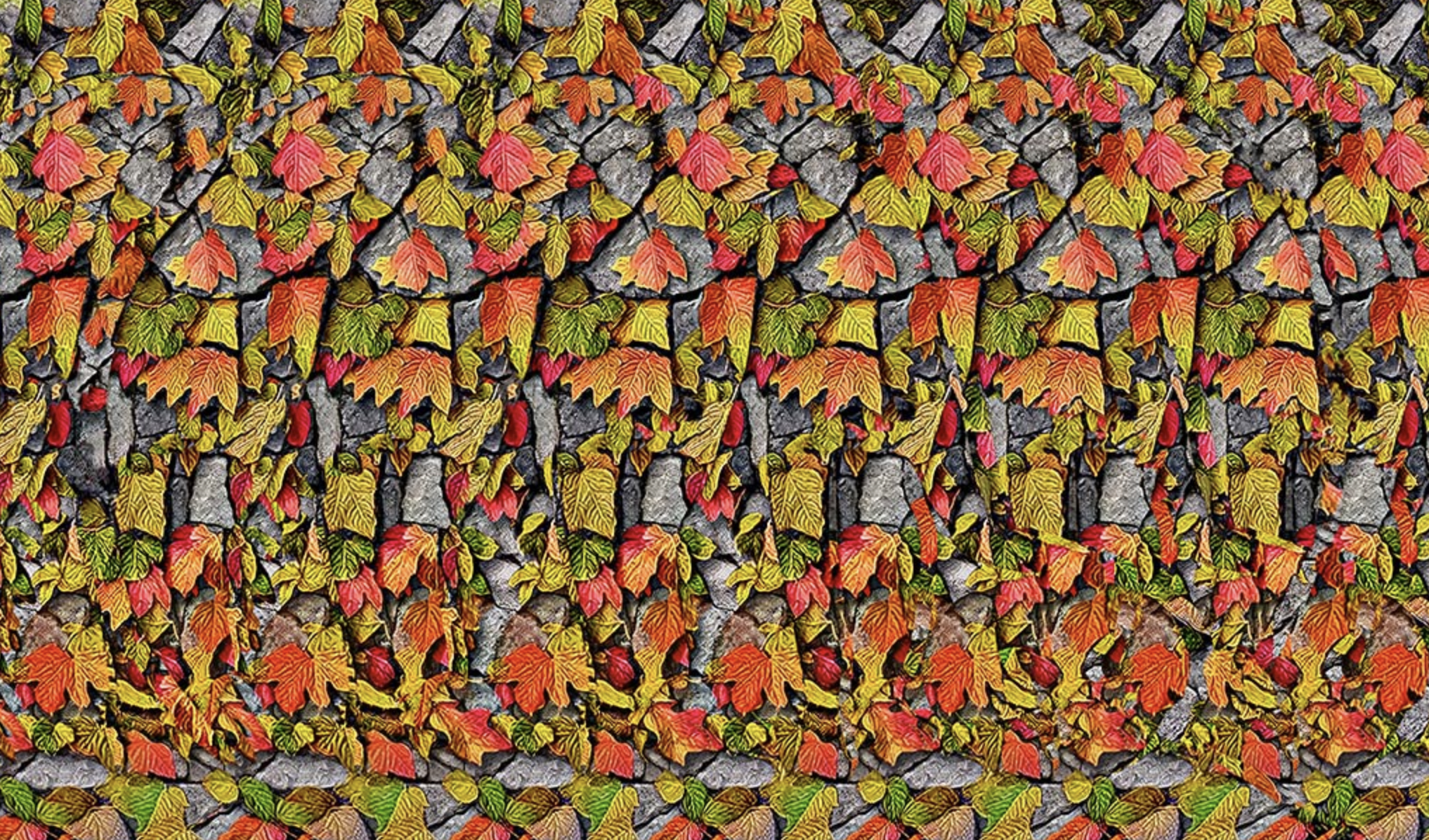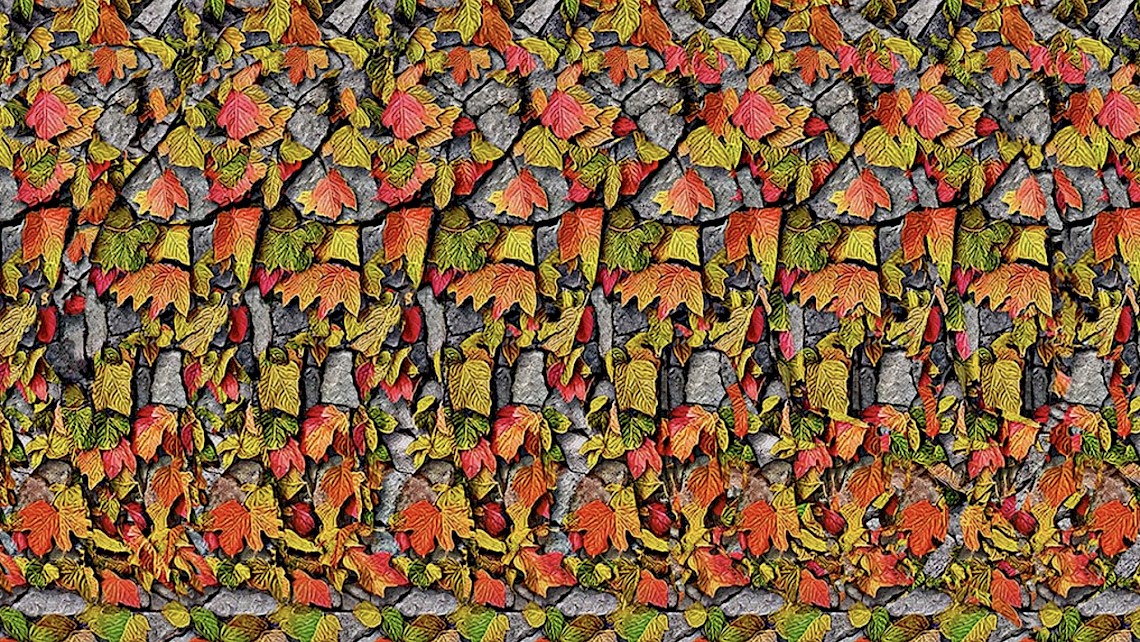Metaphors for the "Extended Common Practice"
Metaphors for the "Extended Common Practice"
Metaphors and Analogies
I’m staking out some positions running up to >The microtonal Village< – an important part of a weekend of concerts September 19 through 22.
The Village Trip American Primitive and Inventors of Genius Weekend
Stereograms
Make the image above fill your screen. Find a spot about 4 or 5 inches from the computer screen. Unfocus your eyes. Cross your eyes. See a winged cat holding something. This is a screenshot and it’s a bit cropped, but it still works.
Interesting to see what our brain does to images. There are waking dreams where you are looking at flattened perspective. It’s strange and unsettling.
Music
–I am attached to 3-D music. I love it. It’s in my bones.
…………This invites a theory of 3-D.
–I love intervals in one context, recontextualized in another. Is that process comparable to the brain trickery we experience with the stereogram?
The effect is juiced up when multiple registers are in play, with elements operating on multiple time scales – the bass moves at a middle ground speed; the melody moves on a foreground speed but lands meaningfully on middle ground time points. Structural notes moving at a background speed. These were important issues for the pre-spectral modernists. Counterpoint of times scales makes Brahmsian proportions feel right.
–I part with Babbitt and side with Dina Koston when I subscribe to Hasegawa’s “tone representation” that tells us we correct to the most simple ratio. I’m inclinded to agree with Hasegawa. I could see an argument for relating all intervals to the nearest 12EDO interval. Babbitt would certainly agree with that. Robert Levin taught that equal temprament was a done deal. That was likely a Boulanger commonplace.
I’m with Dina Koston (also a Boulanger student), who proclaimed that all of her music is rooted in the overtone series. She often ends works with the violin playing the overtone series, untempered.
Babbitt claimed that the overtone series is a strange thing upon which to base a music. He mentioned that in a comment. Obviously, he was thinking about the problem of transpositon, which is my problem also. And yet, by not qualifying the statement with regard to the 7-note origin of 12EDO, he was perhaps being polemical. In my mind I see him **lopping off all the centuries of music where 7 notes relating to transpositions of same tended toward 12EDO** This frisson demonstrates the lengths I am going to reconcile with the post-spectral movements.
For centuries, composers punned intervals. Do that enough and such that the entire circle of fifths is in play, and our tuning starts to accomodate such doings. Doing that does not imply any great love for temperament. Can we think of temperament as a spandrel in the transpositional doings? (See Daniel Dennet.) At any moment of scrutiny, when the conscious mind does its thing on the tuning systems, don’t we tend to see regret and remorse? I asked Robert Morris and he said, it’s a compromise.
Nevertheless, we pre-spectral modernists are so love the 3-D sound space, we tend to be protective of it. It doesn’t require equal temperament, but it tends toward it.
Superconductors
A listening experiment with temperament:
Let’s listen to 4-3 suspensions in JI and in 12EDO.
I confess that I have an overfanciful imagination, but I’m not alone. I’m not sure how prevalent this thinking is. Perhaps it’s safe to say that some pre-spectral modernists fell 027 sets off in our brain the entire interval cycle, the entire 5 cycle.
I don’t see how we can hear Schoenberg op. 9 any other way. It’s not flat. It’s all very 3 or 4 dimensional, multidimensional, with the interval cycles all in a superconducting state, flying off to infinity.
Experiment
Does this superconducting still happen in just intonation? Do we hear a 4-3 suspension in JI as more gravity-bound, more scale degree bound?
A defense of the post-spectral for splenetic pre-spectral modernists
I played in Newband for a spell. I played the adapted guitar. I made one recording with Newband on the Partch instruments. Working that way did a number on me, challenging my inherited, unscrutinized attitudes toward tuning. Bitones I found particularly alluring. Never transposing was disturbing.
Never transposing is disturbing. The Ekmelic conferences in Salzburg are so civilized. Let’s not have black eyes, but are we not ignoring the hard fact that JI pulls the rug out from under the transposing folks, who will see JI as a firm committment to flatness.
Kitty Brazelton & I shared an objection to the Steinway, but our reasoning differed. I am tired of the Steinway because I was so deeply moved by Jed Distler’s presentation about the Burgess Shale (the great proliferation) of piano sounds that we find at the turn of the 20th C. The worlds of 3-D spaces created by *diverse* qualities of the bass, for example, was intoxicating to me. Once hearing that rich diversity, I could never unhear it and the dominance of the Steinway became a liabilty for me. I don’t mind saying it’s the best piano, but that’s not the point for me.
Kitty’s position is more to do with pianos in general. They’re too tempered and too even. She doesn’t need JI. She’s happy with guitars and mandolins, which, as Dean Drummond remarked, are “very Pythagorean”.
The fretted instruments are visually Pythagorean and aurally never perfectly tempered. Milton Babbitt gleefully remarked that his Soli e Duettini for two guitars does not sound tempered.
Listening to John Schneider, Lou Harrison, Castilla-Ávila, Giacomo Fiore, Mario Hurtado, Harry Partch and his instruments, the jangling is irresistible. Who would dare deprive anyone of such riches – the lecture in Salzburg about chromaticisms with wolf-tones! And the jangling has an association, a quiddity.
Quiddities
The overtone series is nature. That’s a thing, that’s aurum potable, a bit of drinkable gold, an extramusical quiddity.
How bizarre the sound of an octotonic scale in just intonation. That pungency slaps us in the face and we take that slap as the force of nature, like cold spring water poured over our heads.
Quiddities bathe our blood stream in good humors. Anything is 3-D when our bloodstream is bathed in good humors.
A war begins when we beat our heads against the wall, confronted with irreconcilable values, contending quiddities.
Harry Partch’s ratios are unique scale degrees, not related to transpositions of themselves, committed against those processes that tend toward temperament.
I think we’re not letting that bother us. Or we’re divided between those in a rational quandry and those who let it go unexamined. Ben Johnston? Does he seem to say, never mind that, put that head trip aside? A Princtonian who loves Johnston’s work claimed that Johsnton averred that tunings for him are an orchestrational matter. I wonder how widely such comments circulate now.
I’m prepared to be wrong about anything, and I welcome correction or redirection.
/////////////////////
“Extended common practice” – That was a whim. The 3-D universe was extended through the period of the pre-spectrtal modernists. 1918 failed to destroy tonality. I consider a good percentage of the pre-spectral modernists to be writing tonal music, no matter how “atonal” it sounds to the uninitiated. I feel extended tonality particularly among 20th modernists who never subscribed to the equal weight diktat – Schoenberg & Babbitt. Not subscribing to equal weight I see as a core principle of Babbitt’s self-proclaimed Schoenbergism.
And despite the fact that Boulez was a guilty party, with Leibowitz, in spreading the anti-Schoenbergian equal weight diktat, much of his work is just so wonderful that we have to forgive him.
I feel equal weight and symmetry death begin to destroy the 3-D sound spaces that I don’t want to abandon. I cannot.









William Anderson is a guitarist and composer and an advisor to the Roger Shapiro Fund.